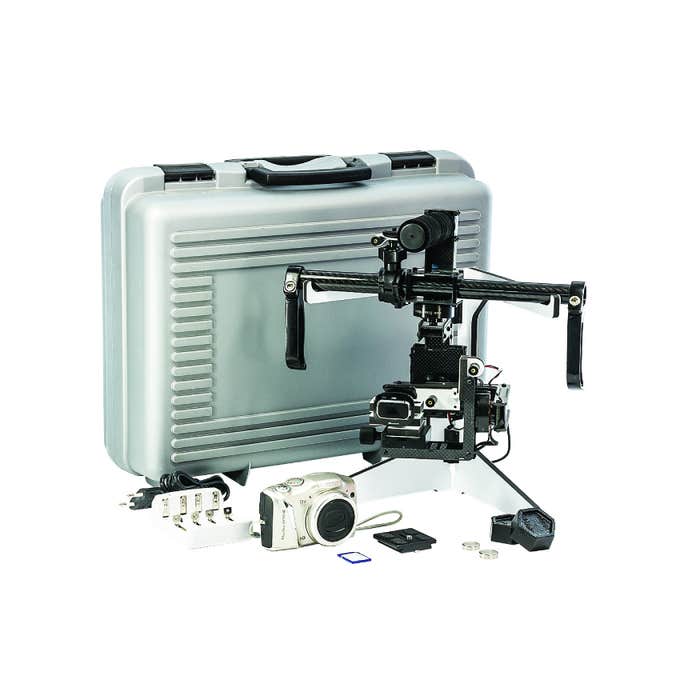Gyroscopic stabilizer case
Discover a 3-axis gyroscopic stabilizer for cameras entirely made of carbon.
Study the materials, PID control, etc...
Contents of the case
• A didactic 3-axis gyroscopic stabilizer with:
A control board for brushless motor with its inertial center, 3 brushless motors, 3 laser projectors with their power supply, a ball joint support, a quick plate,
3 handles and a carbon frame.
• A support for placing or using the steadycam on a table correctly.
• A USB webcam with its support parts to adapt to the steadycam.
• A digital camera for video recording.
• An SD card.
• A USB connection cable.
• A set of 2 weights of 200 g.
• A set of 2 magnets for weight fixation.
• A battery charger.
• A CD-ROM including STI2D and SSI pedagogy:
technical file, teacher's file, student's file, activities and their corrections as well as SysMl modeling, complete SolidWorks®, Mecha3D models and Matlab® and Simulink® multi-physics models.
This gyroscopic stabilizer or also called Steadycam is ideal for creating professional video sequences.
It will allow incredibly stable shots regardless of shooting situations thanks to its 3 motors and its inertial center.
Made entirely of carbon, it is lightweight and ready to use.
With its 3 lithium-ion batteries, its autonomy will allow extended use.
It is equipped with a quick plate to facilitate the disassembly of the recording device.
This steadycam also has a ball joint support to attach a monitor or smartphone (not included) to facilitate shooting.
4 STI2D activities:
A1 - Product discovery
SysML functional analysis.
Setting up and balancing the camera on the stabilizer.
Study of the system with the Mecha3D model in static.
Implementation of the equipment.
A2 - Study of the Pitch axis (or Yaw)
Implementation of the didactic gyroscopic stabilizer and exploitation of the experimental characteristic curves from the laser projections.
Modeling of the tracking on the chosen axis.
Study of the system with the Mecha3D model in dynamics.
Study of a control model on this axis with modification of the PID parameters to highlight their influence.
A3 - Study of the Roll axis
Implementation of the didactic gyroscopic stabilizer and exploitation of the experimental characteristic curves from the laser projections.
Modeling of the tracking on the chosen axis.
Study of the system with the Mecha3D model in dynamics.
Study of a control model on this axis with modification of the PID parameters to highlight their influence.
A4 - Study of materials
Study of the system with the Mecha3D model in dynamics.
Simulation of deformations and mechanical constraints of the model.
Validation of the dimensioning and material choices.
Characteristics of the gyroscopic stabilizer:
Material: 3K carbon fiber, aluminum handles.
Control board: AlexMos 3-axis (BaseCam) for brushless motors.
3 brushless motors type 4008 - 60 KV.
A ball joint support with 1/4'' screw to attach a monitor or smartphone.
Dimensions: 330 x 160 x 240 mm.
Net weight: 950 g.
Power supply: 3 batteries 3.7 V 2900 mA lithium-ion and its charger (included).
Compatible with devices weighing 360 to 440 g maximum (example: Gopro®, SONY 5R, etc).
Basic configuration: Pitch and Yaw axes are in "motion tracking" mode, the Roll axis is in "automatic" mode.
Delivered assembled and ready to use (pre-programmed).
4 SSI activities:
A1 - Product discovery
Discovery and handling of the gyroscopic stabilizer.
Study of static balance according to the position of a webcam.
Study of the Mecha3D model in static.
Implementation of the equipment with a webcam.
A2 - Analysis of controlled axes
Qualitative analysis of position control along the 3 axes.
Implementation of the didactic gyroscopic stabilizer and exploitation of the experimental characteristic curves from laser projections on a plane.
Post-processing of recorded images and analysis of results.
A3 - Understanding of control
Study and modifications of PID control parameters on the real system.
Modification of the Matlab® and Simulink® multi-physics model.
Analysis and comparison of the results obtained.
A4 - Energy and information chain, convert, transmit
Functional and technical study of the product.
Analysis and processing of signals from inertial sensors.
Study of the power control part of brushless motors.





